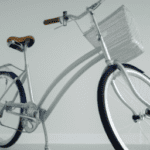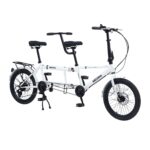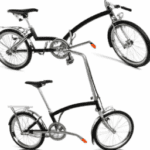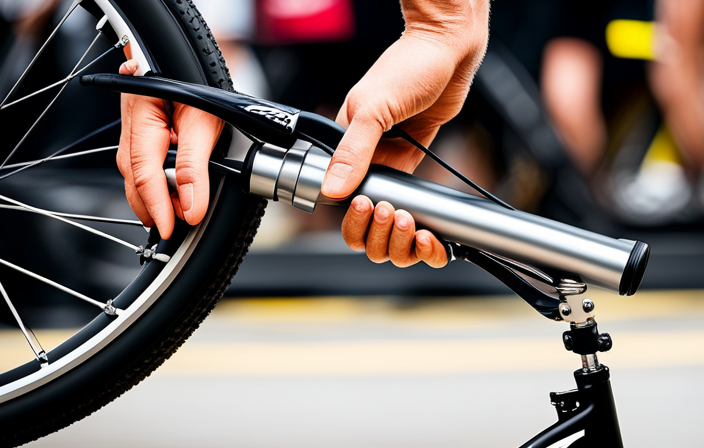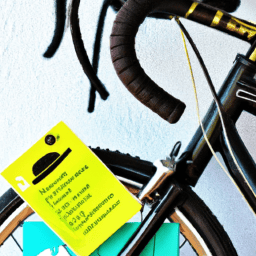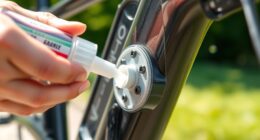As someone who loves cycling, I’ve always been intrigued by tandem bicycles. Were you aware that these bicycles made their first appearance in the 1890s and became popular in the 1900s? Nowadays, riding a tandem bicycle continues to be an interesting and fun method to experience what cycling has to offer.
So, what is a tandem bicycle? Simply put, a tandem bicycle is a bicycle built for two riders. Unlike a traditional bicycle, where one rider sits in front of the other, a tandem bicycle has two seats arranged one behind the other. The riders work together to pedal the bicycle and control the steering.
While it may seem daunting at first, riding a tandem bicycle can be a fun and rewarding experience. In this article, I will delve into the basics of tandem bicycles, the benefits of riding one, and provide tips for choosing the right tandem bicycle.
Key Takeaways
- Tandem bicycles are built for two riders, with the front rider called the captain and the back rider called the stoker.
- Effective communication and cooperation between the two riders is crucial for a safe and enjoyable ride.
- Proper riding form, including pedaling synchronization and balanced weight distribution, can make the ride smoother and more efficient.
- When choosing a tandem bike, consider features like frame material, gears, brakes, comfort, and fit, while also keeping budget in mind.
The Basics of Tandem Bicycles
You’ll love how riding a tandem bicycle allows you and your partner to work together, pedaling in sync towards your destination.
Tandem bicycles are designed for two people to ride together, with one person sitting in the front and the other in the back. The front rider is called the captain, and they’re responsible for steering the bike and controlling the brakes. The back rider is called the stoker, and they’re responsible for pedaling and shifting gears.
Riding a tandem bicycle requires a different riding technique compared to a traditional bike. You and your partner need to communicate effectively, especially when turning or changing directions. The captain needs to provide clear and timely instructions, while the stoker needs to follow these instructions and pedal in unison.
Gear shifting is also important when riding a tandem bike, as the stoker needs to adjust the gears based on the terrain and the captain’s instructions. With practice and patience, you and your partner can master the art of riding a tandem bicycle and have a great time together.
Now, let’s talk about the benefits of riding a tandem bicycle.
Benefits of Riding a Tandem Bicycle
Feeling the wind in your hair and the sun on your face while pedaling in sync with your partner can create an exhilarating experience. Riding a tandem bicycle is not only a fun activity, but it also offers numerous benefits.
One of the most obvious benefits is the physical exercise. Tandem bicycles require more effort to pedal, so riders get a great workout. Additionally, riding a tandem bike is a low-impact exercise that is easy on the joints, making it a perfect activity for people who want to stay active but have physical limitations.
Another benefit of riding a tandem bicycle is the relationship building. Tandem bikes require communication and cooperation between the two riders. Riding together can strengthen the bond between partners or friends, as they learn to work together to pedal in unison. Moreover, riding a tandem bike can also help build trust and improve communication skills between the riders.
Overall, riding a tandem bike is an excellent way to stay active and connect with your partner or friend. In the next section, we’ll provide some tips on how to have a comfortable and enjoyable ride.
Tips for Riding a Tandem Bicycle
As someone who’s ridden a tandem bicycle before, I can attest to the importance of effective communication techniques, safety precautions, and proper riding form.
Communication is key when riding a tandem bike, as both riders need to be on the same page to avoid accidents.
Taking safety precautions, such as wearing helmets and following traffic laws, is crucial for a safe ride.
Finally, proper riding form, including pedaling in sync and maintaining a balanced weight distribution, can make the ride smoother and more efficient.
Communication Techniques
When riding a tandem bicycle, it’s important to communicate effectively with your partner so that you can both enjoy the experience and avoid any potential accidents.
Nonverbal cues such as body language and hand signals can be used to indicate turns, stops, and changes in speed. Verbal communication is also essential, especially when navigating through a busy intersection or making a sudden maneuver.
To communicate effectively on a tandem bicycle, it’s important to establish clear roles and responsibilities. One person should be designated as the captain or the person who steers the bike, while the other person is the stoker or the person who pedals.
The captain should give clear instructions to the stoker, such as when to start pedaling, when to slow down, and when to stop. Meanwhile, the stoker should provide feedback to the captain, such as when they need a break or when they notice any potential hazards on the road.
In addition to effective communication, it’s also important to take certain safety precautions when riding a tandem bicycle. By wearing a helmet, using proper lighting and reflectors, and following traffic laws, you can minimize the risk of accidents and ensure a safe and enjoyable ride.
Safety Precautions
To ensure your safety while riding, it’s important to take precautions such as wearing a helmet and using proper lighting, but have you considered the potential hazards of riding at night without reflective gear?
When riding a tandem bicycle, it’s important to understand the risks and take necessary safety measures. One crucial aspect of safe tandem riding is communication, which includes using hand signals to communicate turns and stops to your partner.
In addition to communication, it’s important to plan your route and assess potential risks before embarking on your ride. This includes choosing well-lit routes and avoiding busy streets during rush hour.
It’s also important to practice emergency stops with your partner to ensure that both of you can stop quickly and safely if needed. By taking these precautions, you can enjoy a safe and fun ride on your tandem bicycle.
Moving on to proper riding form, it’s important to maintain a steady pace and pedal in sync with your partner.
Proper Riding Form
Achieving proper riding form is crucial for a smooth and efficient ride on a tandem bicycle. To start with, pedaling synchronization is key. Both riders need to pedal in unison, ensuring that both sets of pedals are moving at the same pace. This will prevent one rider from having to constantly brake to keep from colliding with the other rider’s pedals. It’s important to maintain a consistent pedaling rhythm, especially when going uphill or downhill.
Communication signals are also important when riding a tandem bicycle. Verbal communication may be difficult due to wind noise and the distance between riders, so it’s essential to agree on signals before starting the ride. A tap on the shoulder, a gentle squeeze of the thigh, or a hand signal can all convey important messages without the need for words.
For example, a tap on the shoulder can signal a need to slow down or stop, while a squeeze of the thigh can indicate a need to shift gears. By communicating effectively, both riders can avoid accidents and enjoy a safe and successful ride.
To transition into the subsequent section about choosing the right tandem bicycle, it’s important to consider how proper riding form can be affected by the bike itself. Choosing a tandem bicycle that fits both riders comfortably and has the right features for the type of ride you plan to take is essential for achieving proper form and enjoying your ride to the fullest.
Choosing the Right Tandem Bicycle
When choosing a tandem bicycle, I always consider my riding style, fit, and comfort, and budget.
First, it’s important to think about the type of riding you’ll be doing. Will it be for leisurely rides or more intense cycling? This will affect the frame material and design you choose.
Second, getting the right fit and comfort is crucial for both riders, as you’ll be sharing the same bike.
Finally, setting a budget will help narrow down your options and ensure you get the best value for your money.
Consider Your Riding Style
Riding a tandem bicycle is like having a dance partner on wheels, so it’s important to consider your riding style to ensure you’re in sync with your partner.
Here are some things to keep in mind when choosing a tandem bike based on your riding style:
- If you’re more interested in speed, look for a tandem with a more aggressive riding position and narrower tires. If you prioritize comfort, opt for a more upright position and wider tires for a smoother ride.
- Tandems can handle off-road terrain, but if you plan on doing a lot of off-road riding, look for a tandem with suspension and wider tires. On-road tandems may have narrower tires and a more aerodynamic design.
- Tandem riding requires communication and trust between partners, so if you’re a beginner, look for a tandem with a more stable frame and easy-to-use gears. More experienced riders may prefer a lighter frame and more advanced gears.
- If you plan on riding longer distances, consider a tandem with more comfortable seats and handlebars that are adjustable for different riding positions.
- Some tandems come with special features like disc brakes or electric assist, so consider what features might enhance your riding experience.
When considering your riding style, it’s important to also think about fit and comfort for both you and your partner.
Fit and Comfort
As I mentioned earlier, when choosing a tandem bicycle, it’s important to consider your riding style. However, it’s equally important to ensure that both riders are comfortable and properly fitted on the bike.
This can be achieved through proper saddle adjustments and handlebar customization. Saddle adjustments are crucial to ensure the comfort of both riders. It’s important to adjust the height of the saddle so that the rider’s leg is almost completely extended at the bottom of the pedal stroke. In addition, the tilt of the saddle should be adjusted to ensure maximum comfort and support.
Handlebar customization is also important to ensure that both riders have a comfortable grip. The handlebars should be adjusted to the proper height and angle to ensure that both riders have an optimal riding position.
Now that we’ve discussed the importance of fit and comfort on a tandem bicycle, the next step is to consider your budget. It’s important to keep in mind that while there are many factors to consider when choosing a tandem bike, your budget will play a significant role in your decision-making process.
Budget
Now, you need to consider your budget for buying the perfect tandem bike that suits your needs and preferences. Tandem bicycles can be quite expensive, and it’s important to find affordable options that fit within your budget.
When searching for a tandem bike, it’s important to look for cost-effective upgrades that can enhance your riding experience without breaking the bank. One way to save money on a tandem bicycle is to consider purchasing a used one. Many cycling enthusiasts upgrade their bikes frequently, leaving their old ones in good condition and available for purchase at a lower price.
Additionally, some bike shops may offer discounts on previous year models or have sales throughout the year. When considering upgrades, look for options that provide the most benefits for the lowest cost, such as upgraded pedals or handlebars.
With careful research and consideration, it’s possible to find a quality tandem bicycle that fits your budget and provides an enjoyable riding experience.
Frequently Asked Questions
How do you store a tandem bicycle?
To properly store my tandem bike, I use a wall mounting system that keeps it out of the way and organized. I also use a bike cover to protect it from dust and scratches.
Can a tandem bicycle be ridden by only one person?
Yes, a tandem bicycle can be ridden by only one person. This is called solo riding. However, it requires practice to maintain balance and control. Tandem cycling clubs also offer opportunities for solo riders to join group rides.
What is the weight limit for a tandem bicycle?
The weight limit for a tandem bicycle depends on weight distribution and frame strength. Comfortability is key, so finding a bike with a sturdy frame and adjustable components can ensure a safe and enjoyable ride for all.
Are there any specific safety precautions to take when riding a tandem bicycle?
When riding a tandem bicycle, communication and riding in sync with your partner is crucial for safety. Always wear helmets and check the bike’s brakes, tires, and chains before riding. Use hand signals for turning and stopping.
How do you transport a tandem bicycle?
Transporting a tandem bicycle can be tricky, but with some tips and tricks, it can be done easily. The best car racks for tandem bicycles are ones that are sturdy and can hold the weight. Make sure to secure the bike properly before driving.
Conclusion
Well folks, after all that technical jargon and informative tidbits, it’s time to put it all together and see what we’ve learned about tandem bicycles.
Frankly, it seems like a lot of work just to ride a bike with someone else, but who am I to judge? I mean, if you want to be connected to your partner in every move you make, then by all means, go for it.
But in all seriousness, riding a tandem bicycle can be a fun and unique experience for couples or friends. It requires communication, trust, and patience, but the benefits can be rewarding.
Just remember to choose the right bike for your needs, practice safety precautions, and have a good sense of humor when it comes to navigating together. Who knows, maybe you’ll even become the next great tandem bicycle team.
Happy riding!


